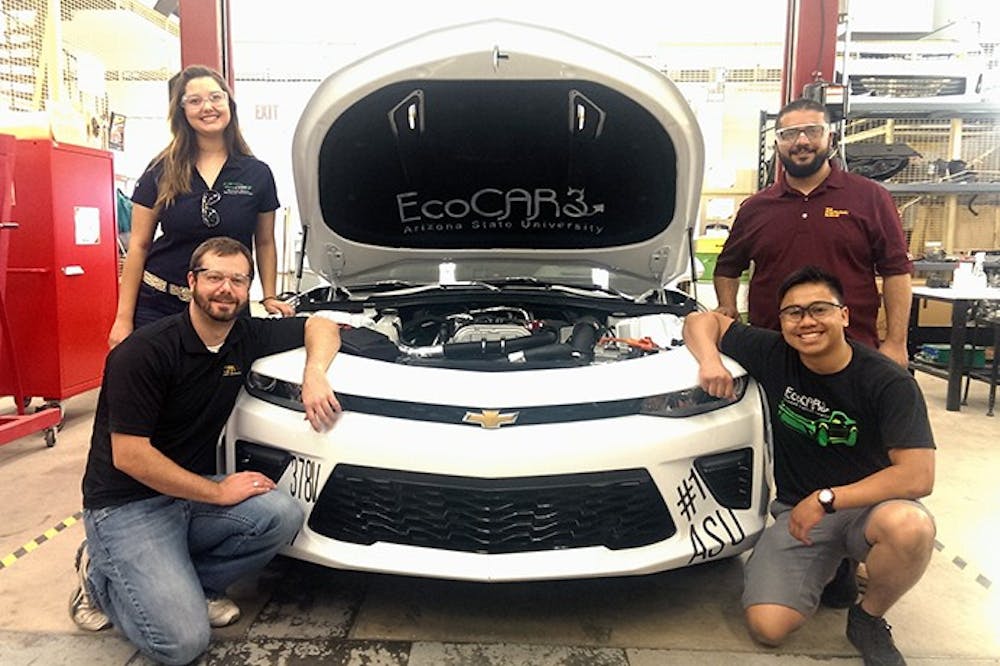A group of students on ASU's Polytechnic Campus nearly have their self-made, energy-efficient Chevrolet Camaro up and running.
Students working on EcoCAR 3, a competition across colleges nationwide, are tasked with taking a baseline-model General Motors car and using the tools available through their university to make the vehicle innovative and unique to their school.
The competition takes place over four years and consists of 16 teams. ASU's team started work in the fall 2014 semester and planned the project through the fall 2015 semester. The team then started physical work on the car during the spring 2016 semester.
Josh Carroll, graduate research assistant and engineering graduate student, heads up a large part of the research on ASU's EcoCAR 3 team.
A Navy veteran, Carroll said he picked up a great deal of the necessary mechanical skills through his time in the armed forces. The project has also given him a chance to give back, he said.
"It's given me time to focus on research," Carroll said. "It's given me time to mentor the next generation of leaders."
Carroll said he sees the American automotive industry in need of revival. Through this project, he said he hopes to bring the innovation and out-of-the-box thinking necessary in restoring American automobiles to their former glory.
"Our biggest lack has been an ingenuity of vehicles," he said.
The U.S. Department of Energy, Siemens, MathWorks and several other groups have sponsored the EcoCAR 3 competition and provided funding to the schools involved.
Carroll said donations and sponsorships have provided upwards of $74 million toward software and other tools needed to work on such a car. The software also goes toward the University as a whole, rather than just those working on the car.
Briana Del Bianco, a communications manager and master's student studying technical communication, said this is one of the most important, yet often overlooked aspects of the program.
"It's helping us teach all the engineers of the future," Bianco said.
Carroll said ASU has an edge on the competition with their research facilities, although the school did not place high in the second year of the contest.
"We probably have the best labs out of the 16," he said. "We placed 15th in year two. ... We've had our ups and downs, but the fact this was done by students is remarkable."
Carroll and his team planned their work on the car until January, when they started the re-hauling process. They had until May to get it up and running in the final leg of the competition's second year.
Of the 16 schools, he said only four were able to successfully start their vehicles. ASU was not one of the four.
Although students are completely revamping the vehicle, everything on the ASU Camaro is General Motors-approved.
The engine is the same used in a Pontiac Solstice or Saturn Sky, Carroll said, though the car originally had a standard V6 engine, commonly used in the 2LT Coupe model of Camaros.
Carroll and his colleagues have more work in store for them, as they are only halfway through the competition. He said that over the last semester, he clocked about 120 hours per week on the project. Most students work about 20 hours per week on it.
"This is more like a family than anything else," Carroll said. "It's creating a culture for students to find themselves in this program."
In keeping with a family spirit, Carroll said he helps everyone on the team get involved in any capacity they want. Bianco made some of the car's parts, a job which a communications manager usually would not have any involvement with, he said.
Carroll and Bianco said the project helps engineering students even out their resumes by giving them several years' worth of on-the-job experience by the time they graduate.
"For me, personally, this has been about working with a diverse crowd," Bianco said. "Even if you don't know anything about cars, this is a great program to be in."
Bianco said students of any major can join the program and work in communications and public relations if they are not looking to gain mechanical experience.
As the ASU EcoCar3 team crosses the midway point of the competition, Carroll said they are hoping to have the car up and running within three months' time.
Josh Bounlangsy, mechanical engineering senior and mechanical team lead assist, said working on EcoCar3 has helped him expand his horizons.
"It's a huge learning experience just to see the teamwork," he said.
Bounlangsy said he is grateful to have the experience from working on the car. They have matched, step-for-step, the process automotive manufacturers undergo when creating a car, he said.
Mohammed Alzorgan, graduate research assistant and PhD student studying mechanical aerospace engineering, said the research has provided unparalleled experiences for the students working on it.
"The interesting thing about this: We're doing things on a real, industrial scale, the same way GM does it," he said. "It's the perfect opportunity to close the gap between education and industry."
Reach the reporter at jwbowlin@asu.edu or follow @mrjoshuabowling on Twitter.
Like The State Press on Facebook and follow @statepress on Twitter.




